Two-lane roads, Burma Shave signs, and Mail Pouch Tobacco barns made this family’s first lengthy auto trip a memorable adventure.
Who needed a car?
In late spring of 1945 we moved from the outer edge of our small steel-mill town on the Ohio River (Ambridge, Pennsylvania) to a downtown apartment on Sherman Street. From here we could easily walk anywhere we needed to go: to schools, the library, theaters, hardware store, post office, barber shop, bank, bus stops, the Pennsylvania Railroad station, and Dad’s job at the H. H. Robertson Company.
There was now scant need for owning, insuring, and maintaining a car. So Dad sold his 1935 Buick Sedan (a luxury car he purchased affordably from a financially distressed bank president during the Depression). After the end of WWII, cars were scarce, as automobile factories had retooled for defense production all during the war years. So selling prices were high, and Dad got back as much as he paid for it, maybe more.
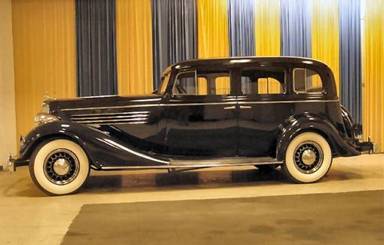
1935 Buick Sedan
By early summer of 1952 our Dad, as dads often do, got bit by the "I want another car" bug. Mom, the thrifty parent, thought we should get a low-priced used Chevy. Dad, who felt otherwise, chose to take me (man to man; I was 15) rather than Mom, along on his shopping trip.
Buying a car was a really big deal in those days. We didn't have opportunities to make many expensive purchases (upscale stereo systems, Rolex watches, wide-screen TVs, etc). Not only were expensive objects unavailable, most people couldn't have afforded them anyway. Credit cards weren't in use, and "middle class" in the 1950s was on a much lower, simpler scale than it is today. Housing and cars were usually the only large expenses folks had.
"Ted, let's take a walk," suggested Dad.
It was very easy to tell immediately which brand of car you were looking at then, as each had a unique design and an image that went with it. We looked at a Chevy first. No spark of interest flickered, and he declined a test drive. Going upscale a little, we looked at a 1947 Hudson.
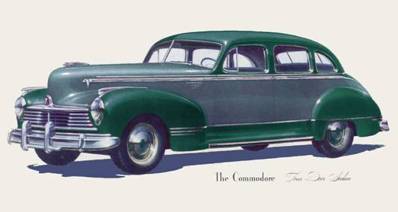
1947 Hudson, a warmed over 1930s design.
The lady used-car dealer took us on a drive up the steep hill to the Country Club, but stalled the car half-way up. Attempting to restart, she rolled into a car stopped behind us. Dad kept quiet, but I could tell he was disgusted. After these half-hearted attempts to check out economy cars, Dad and I walked from the Hudson dealer to Sharman Buick’s used car lot, on Merchant Street.
There I saw my dream car.
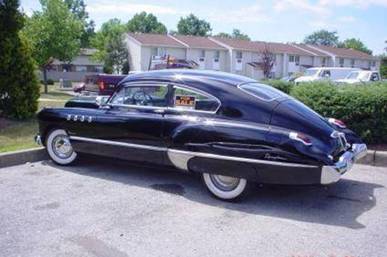
1949 Buick Roadmaster Sedanette.
"Hey, Dad, let's get this one!" I pleaded. Dad was impressed, but then pointed out that we needed a four-door sedan to take Grandma Blishak around town on her errands. The salesman directed us to another used Buick.
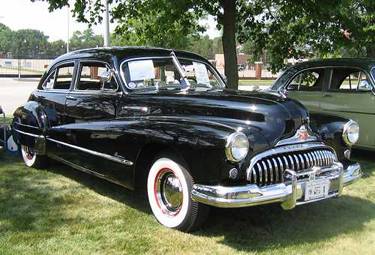
1948 Buick Super Sedan.
Dad's eyes lit up -- he was a Buick man, accustomed to the luxury of the old 1935, and liked this one, with its Fireball Straight 8 engine! It had a radio and a heater, which only luxury cars had in those days. Air conditioning wasn't available for cars in that era. The deal was closed at $1,195.00, and Dad took the keys.
We drove it home to Sherman Street. Mom, who might have tried to nix the deal had she come along, said, "I'll feel conspicuous having such an expensive car parked out front. (Our old row apartment building did not have garages.) Won't the neighbors think we are getting ahead of ourselves?"
In fact, few neighbors owned cars at all.
Naturally, with such a vehicle at our disposal, we had to take a drive. Brother George, age 10, and I sat in the back seat. It was a long drive, to Baltimore, Annapolis, the Atlantic Ocean, and Washington, DC. We were on two-lane roads most of the way, as there was no Interstate Highway System in 1952.
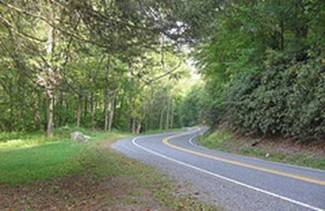
Scenic two lane byway, the way things were.
There was some entertaining roadside advertising then. You may have heard of the Burma Shave signs, which were spaced far enough apart that you could only read one phrase at a time, and always fun to read. They were changed from time to time.
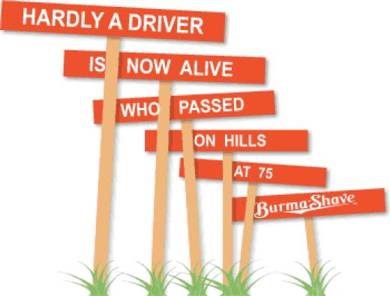
The jingles had messages about highway safely as well as some praising the shave cream.
| |
DON'T STICK YOUR ELBOW OUT SO FAR
IT MAY GO HOME
IN ANOTHER CAR.
Burma Shave |
|
DON'T LOSE YOUR HEAD TO GAIN A MINUTE
YOU NEED YOUR HEAD
YOUR BRAINS ARE IN IT
Burma Shave |
|
NO MATTER THE PRICE NO MATTER HOW NEW THE BEST SAFETY DEVICE IN THE CAR IS YOU
Burma Shave |
|
We purchased a canvas bag in which to store water and hung it on the front bumper. It kept the water cool by evaporation.
These were in the days before there were “convenience stores” in the tens of thousands throughout the country, with chilled drinks and bottled water for sale. In fact, there weren’t any convenience stores at all, period.
Motoring east across the Appalachian Mountains, then turning down into Maryland, we had our first typical experience with Maryland country dogs. Dad had to come to a full stop to avoid running over a dog that was sleeping on the pavement. Later, we encountered more additional listless, sluggish, dogs wandering onto the streets in front of us. Mom commented, “These must be the “dog days of summer!” We all laughed, and we could tell that Mom was pleased with thinking up that little joke.
Now that we were south of the Mason Dixon Line, verbal communications became dicey as we encountered the Southern drawl. Regional accents were much more pronounced then, as TV hadn't yet homogenized the way Americans speak. I listened curiously as a rural gas station attendant gave us directions. Mom and Dad just looked at each other mystified, thanked him courteously for his advice, and drove down the road a bit to consult a map.
"We might as well be in a foreign country," Mom remarked.
Our first stop was Baltimore where we got our first look at ocean-going freighters and sea water in smelly Baltimore harbor. (Nothing like the restored and developed tourist attraction of today.)
Heading east towards the sea, we stopped at the Naval Academy at Annapolis, where we watched cadets marching in formation on a grassy parade ground.
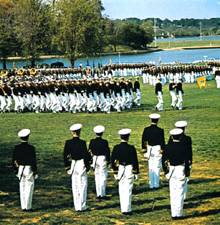
Navy cadets on parade
A bored cadet was keeping rhythm on a snare drum, and asked, "Sir, would you please light a cigarette for me?" Dad did, and the cadet continued without missing a beat. After watching the marching drill, we enjoyed seeing cadets and their instructor cast off from a nearby dock in a USN sailboat, the instructor barking orders and the cadets quickly responding.
A ferry connected the two Maryland shores, but a new Chesapeake Bay Bridge opened on July 30, 1952. As we took the trip in August, we drove across.
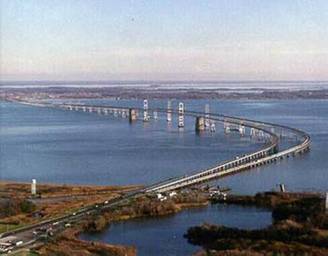
Chesapeake Bay Bridge
Our destination was the Atlantic Ocean at Rehoboth Beach, Delaware, where we checked into a modest tourist home just a block or two from the sea. Not to be mistaken for the Bed & Breakfasts of today, tourist homes were merely private residences with one or more spare rooms rented to travelers.
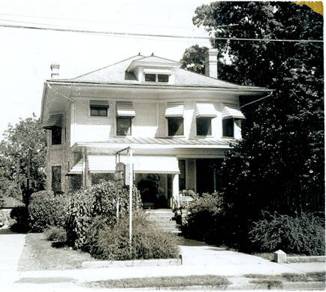
A not untypical tourist home of the 1950s.
Rehoboth at that time was a very quiet and uncrowded summer resort, with just a handful of bathers on the beach. But then the US in 1952 was home to only 157 million souls, about half of today’s population. Could we ever have imagined a doubling of our population in only 60 years? The beach is a little more crowded today.
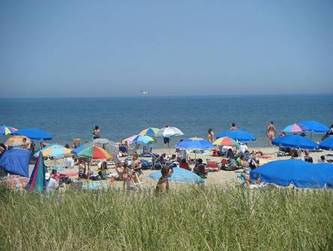
Rehoboth Beach today.
On the drive west towards Washington, DC, we made a refueling stop at a nondescript country gas station. It was hot. It was humid. The sun was beating down on my head. Mere water could not relieve my thirst. But there was a familiar Coca-Cola vending machine and I had a nickel. The traditional Coke bottle appearing with a distinctive "clunk" was frosty to the touch. Snapping off the cap, I put it to my mouth, and was treated to an icy cold explosion of fizz and flavor which smarted my nose. Six ounces was all that was needed to quench the thirst, lift the spirits, and clear the sinuses. The Coca-Cola company does not admit to having drastically changed the recipe over the years, but those of us who've been around awhile know the difference! Those of you who enjoy the flat, corn syrupy, Cokes of today, may not even enjoy the Coca-Colas of the past.

We looked for a tourist home in the residential neighborhoods of Washington DC adjacent to downtown. Unfamiliar as we were with the South, we soon learned that these residential districts were segregated. We were shocked to see public buildings with signs directing "colored" people to drinking fountains and restrooms. We had never experienced this in Ambridge. Yes, travel is broadening, but it can bring you in touch with some things that you may not want to know.
We settled for an inexpensive hotel, then we found a Grayline Tour Office, where Dad booked a city tour. At the FBI Building, with its basement firing range, we witnessed a “Tommy” gun, the predecessor of today’s ubiquitous assault rifles, in action. My memories of the Treasury Department printing office are vague. Even as a teenager, I found my energy sapped by the heat and humidity of our capitol city. Air conditioned public buildings were the only relief. Citing the stifling heat and humidity as her reason, Mom ordered a glass of beer for herself with lunch. I never saw Mom drink a beer before or after that.
One part of the tour stands out in vivid memory. This was a steamboat ride down the Potomac to George Washington’s Mount Vernon home. It was cooler on the water. While I had little interest in historic buildings, I was mesmerized by the multi cylinder reciprocating steam engine driving the ship. The engine room was open to the passenger decks, and I spent considerable time hanging onto the rail overlooking this massive piece of machinery flailing silently below me.
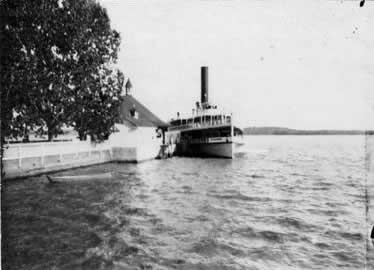
View of a steamboat at Mount Vernon dock
We spent one other day in DC to visit the public buildings and monuments.
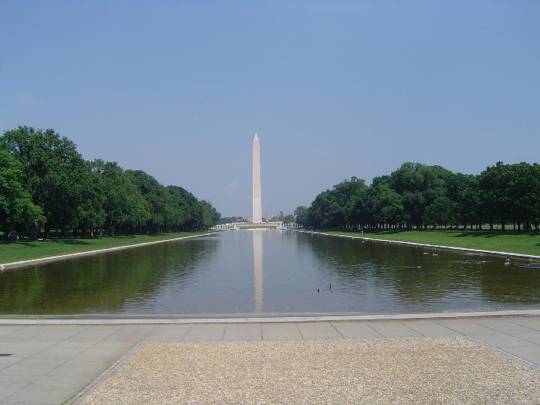
Washington Monument.
From the top, the mall spread out below us like a map. We took the elevator up, and discussed going back down on the steps, but our ambition was stifled by the heat and humidity.
We made an overnight stop on the trip home, at the Green Lantern Motel in Capon Bridge, WV.
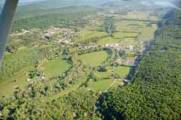
I recall the picturesque hillside setting of the individual cabins, the walkways illuminated by small electric lights installed low the to the ground. As I look at a map of the route from DC to Ambridge, it is located on US Highway 50, about 100 miles west of DC and 200 miles from Ambridge.
We enjoyed another form of roadside advertising as we headed back towards Pennsylvania. A Mail Pouch Barn has one or more sides painted with advertising for the West Virginia Mail Pouch company, which sold chewing tobacco. Barn owners were paid a small amount for displaying these ads. But more importantly, they received a much desired fresh coat of paint to preserve the integrity of the wood. Mail Pouch painted their message on one or two sides of the barn (depending on viewability from the roadway) and painted the other sides of the barn any color the owner wished. Many of the barns were repainted every few years to maintain the sharp colors of the lettering.
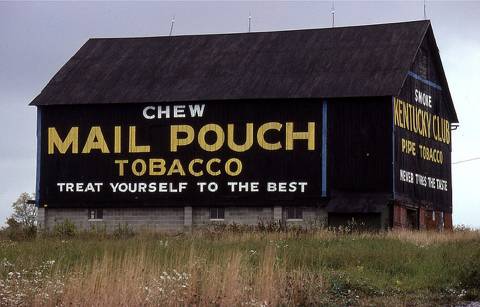
Chew Mail Pouch Tobacco
Until this excursion, we had little experience with owning a family car, or for traveling far from home. This was not an activity that most friends and relatives indulged in. So our big motoring adventure opened up new vistas for us. It whetted our appetites for more travel, leading to auto trips to Florida in 1953, and cross country trips in 1954 and 1959. But those are other stories!
Regards, Sylvia Blishak, Train Travel Consulting at Accent on Travel. [email protected]
NAMED ONE OF THE WORLD'S TOP TRAVEL SPECIALISTS BY CONDE NAST TRAVELER MAGAZINE SINCE 2002. 3939 S. Sixth St. #331, Klamath Falls, OR 97603 Phone: 800 347 0645 Fax: 541 883 6457 http://www.traintravelconsulting.com
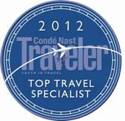
|